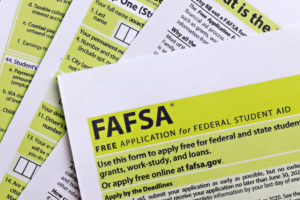 In a previous blog post, I wrote about how the Free Application for Federal Student Aid, or FAFSA, is going to change this year. Recently, the Department of Education announced the new form might not be ready by October 1, the date on which the application has opened since 2016. Legally, the agency has until January 1 to release the form. If the FAFSA isn’t released on October 1, students will likely experience delays in getting financial aid offers. We will keep you posted on future announcements from the Department of Education.
In a previous blog post, I wrote about how the Free Application for Federal Student Aid, or FAFSA, is going to change this year. Recently, the Department of Education announced the new form might not be ready by October 1, the date on which the application has opened since 2016. Legally, the agency has until January 1 to release the form. If the FAFSA isn’t released on October 1, students will likely experience delays in getting financial aid offers. We will keep you posted on future announcements from the Department of Education.
In the meantime, let’s focus on the changes. One of the most welcomed changes is that the number of questions on the FAFSA is being reduced, from over 100 to about 32. This should make an unwieldy process a bit less cumbersome.
The Expected Family Contribution (EFC) will be renamed the Student Aid Index (SAI). While this may seem like semantics, the EFC told families how much money colleges would expect them to pay, but many colleges expected more. The SAI, on the other hand, tells families how much aid they should receive. Additionally, a family’s SAI can be as low as -$1,500 as opposed to the current FAFSA formula, which doesn’t permit an EFC of less than $0. This change will help students whose families have very low-incomes to obtain aid greater than the cost of attendance. Students could use the additional money to purchase a computer or pay for other living expenses while at college.
The removal of “Income Add-Backs” is another positive change for families. Currently, if you contribute to a pre-tax retirement plan (401K or 403b), those contributions are considered income. Starting with the 2024-2025 school year, those pre-tax contributions will not be counted as income. This change should increase the amount of aid students qualify for.
Received child support will also no longer be added to parents’ income. Instead, this amount will be added to your non-retirement asset total, but assets don’t count as heavily in the SAI calculation as income does.
Another beneficial change is that students whose family members or friends want to help pay for college will get a break. In the past, this financial assistance was considered untaxed income to the student. Going forward, that won’t be the case, meaning funds from a grandparent-owned 529, for example, will not negatively impact the SAI.
While these are helpful changes, there are others which will negatively impact many families.
According to College Aid Pro, for students whose parents are divorced, “instead of reporting financial information on the parent (and spouse, if applicable) with whom the student lived most of the year, the new formula requires information on the parent (and spouse, if applicable) who provided the majority of the student’s financial support regardless of who the student lived with.” This change could dramatically reduce the SAI.
Perhaps the most detrimental change affects families with multiple students in college at the same time. Previously, the EFC calculation was divided by the number of children in college. The SAI does not take this into account. Eliminating this discount is going to make it much harder for families to pay for college and may lead to a worsening of the student debt crisis. There are groups advocating to have this part of the FAFSA Simplification Act repealed.
Another less than helpful change: families will be required to include the value of their small business or farm on the FAFSA. This value will likely reduce the amount of the SAI.
All families should keep in mind that appealing a financial aid offer is always an option. An appeal or “professional judgment” allows financial aid officers to make adjustments for special circumstances such as loss of income, housing change, large medical expenses and multiple family members enrolled in higher education simultaneously. If your EFC is higher than expected or the new SAI is lower than you’d hoped, leading you to less financial aid than needed, think about making an appeal.





